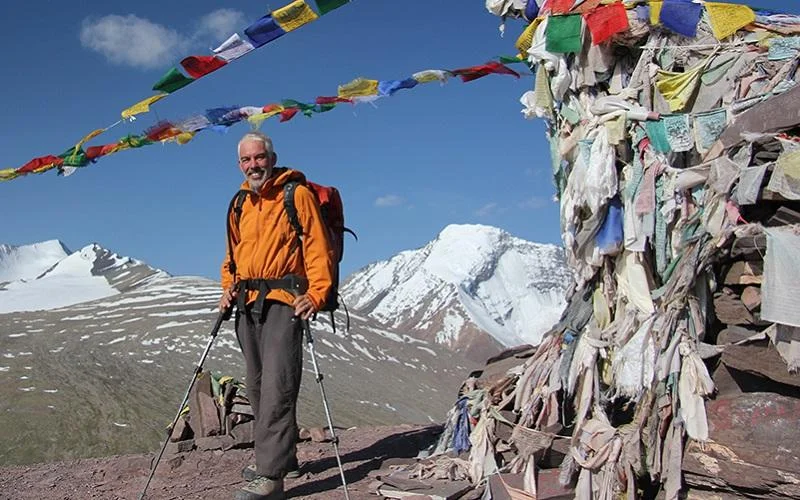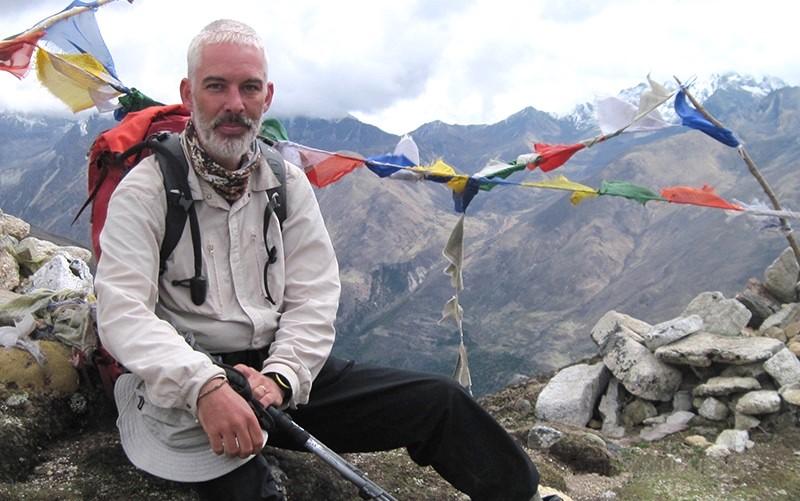Robin Boustead






Robin Boustead is a man on a mission. His passion for adventure and sustainability has taken him on a journey to create the Great Himalaya Trail, a 4500km-long trekking route that covers the entire Himalayan range. But it's not just about adventure; for Robin, the Great Himalaya Trail is a platform for promoting sustainability and responsible tourism in the region.
The Great Himalaya Trail is not just about trekking; it's about creating a sustainable tourism industry in the region. The project's vision is to promote responsible tourism by involving local communities and creating opportunities for them to benefit from tourism. By doing so, they can help protect the environment and the local culture while also providing a unique experience for tourists.
One of the key challenges that companies face in adopting sustainable practices, according to Robin, is the lack of awareness and understanding of what sustainability means. Many companies see sustainability as an additional cost or something that is not relevant to their business. However, Robin believes that sustainability should be viewed as a core business strategy that can create value in the long run. Companies can benefit from sustainable practices by reducing their costs, enhancing their reputation, and attracting a more loyal customer base.
The Great Himalaya Trail is also a perfect example of how collaboration can be a powerful tool in promoting sustainability. The project involves multiple stakeholders, including local communities, government agencies, and NGOs, all working together to promote sustainable tourism in the region.
Overall, Robin's vision for the Great Himalaya Trail is to create a sustainable tourism industry that benefits both the environment and local communities. Through his work on the Great Himalaya Trail, Robin has demonstrated that sustainable tourism is not just a concept but a tangible reality that can create value for all stakeholders involved.
Areas of expertise:
Robin Boustead on the Great Himalaya Trail and Promoting Sustainable Tourism in South Asia
Robin, can you tell us about your journey towards founding the Great Himalaya Trail? What motivated you to embark on this endeavour?
The holiest mountain for Buddhists and Hindus, in fact the centre of their spiritual universe, is Mount Kailash in western Tibet. It is said that you cannot choose to go to Kailash, rather, Kailash chooses to let you come.
In 2008, after many years of trekking in the Himalaya, researching and mapping new areas, I decided to make a personal pilgrimage to Kailash by starting at Kanchenjunga on the eastern border with Nepal and India.
This meant doing something that had never been done, linking all of Nepal’s himals (mountain ranges) into a single continuous route. It took 162 days to reach the western border with Tibet and within 3 days of reaching Kailash.
It was an incredible journey that relied heavily on local community support, which made me and my small team of Sherpas incredibly grateful. But the week we arrived at the border, the Chinese had closed it. I have still not been to Kailash.
On returning to Kathmandu, I felt that I had failed. My friends thought the opposite, I had done something that was the dream of many, and they insisted I publish the journey in a book.
While writing and making new maps, I realised that I had created something that could be called the Great Himalaya Trail, and it could be a vehicle for promoting responsible, community-sensitive mountain tourism. It could bring income to villages that were thought by many in Kathmandu to have little, if anything, to offer tourism.
So, what was a failed mission for me, gave birth to a project that ended up covering the entire Himalaya and establishing the principles and practices of sustainable tourism over 4500km.
How does the Great Himalaya Trail promote sustainability and responsible tourism in the region? Can you share some examples of the positive impact it has had on the local communities and environment?
Over the last 15 years, I realised that, although the villagers themselves live in a very sustainable way, the trekkers and outfitters that supported them needed guidance on how to minimise their negative impacts.
This began by creating Codes of Conduct, then a simple carbon footprinting system and more recently, a community impact assessment model that empowers villages to take control of their relationship with tourism.
One of the first simple steps was to minimise foreign foods from being offered to trekkers. The traditional meal in Nepal of Dhal Bhat, of rice, lentils, vegetable and home-made pickles, is the perfect sustenance for months of being in the mountains and certainly far more sustainable than imported pasta!
In the last year, we now see communities making their own rules and control systems for managing tourism. It’s not perfect, but these small steps will eventually lead to a fairer and more balanced approach to remote area tourism.
Beyond Nepal, the ripples of the GHT flow far and wide. Similar long-distance adventure routes are springing up, for example in Kazakhstan and Kyrgyzstan, that will link with the GHT.
Bhutan has a new trans-Bhutan trail as a lower option to the higher GHT route and is planning to make it completely carbon-neutral.
I have also coached 170 travel operators across South Asia to embed sustainability in their day-to-day operations, as well as collectively push their state and national governments to take sustainable tourism to heart.
You mentioned in our earlier conversation that you are currently working on matching ESRS reporting with sustainability certification criteria. Could you elaborate on this work and how it can help companies embed sustainable and responsible practices?
Sustainability certification systems around the world focus on operational reporting and actions. These are great initiatives but have had relatively small impacts when compared to the overall tourism sector.
The introduction of the European Sustainability Reporting Standard (ESRS) will mainstream sustainability reporting, especially the up- and down-stream elements required for Scope 3.
Even if you are a smaller company, you might have a client who must fulfil the ESRS statutory reporting requirements, which means they will come knocking on your door for information about your impacts.
Working out how to create a scalable, affordable and intuitive system for small to medium sized enterprises to comply with ESRS demands is a challenge that I’ve been working on for the last year.
A fundamental hurdle is to avoid creating a system that only ‘reports’ and instead ‘guides’ companies on reducing negative impacts and building a more resilient, circular system.
In your opinion, what are some of the key challenges that companies in your region face in adopting sustainable practices? How can they overcome these challenges and make sustainable practices a part of their core business strategy?
South Asia is not an easy place to promote sustainability as there is an immediate assumption that it is a ‘western idea that will cost money’.
So, I spend a lot of time running workshops that focus on day-to-day operational changes that will save money and improve the quality of products and services.
I develop simplified tools, for example communication packs and carbon-calculators, as well as building soft skills like staff management and motivation programs, that deliver immediate, positive changes in companies.
When owners and management see how easy it is to make changes and save money, they quickly realise that there is much more they can do, and then they begin a sincere sustainability journey.
What advice would you give to individuals and organizations looking to make a positive impact on sustainability and the environment? How can they get started and make a meaningful difference?
It begins with a choice, are you concerned about what is happening with the climate or not? Are you concerned about the impacts on people’s lives? On the environment?
If you answer yes to any of these issues, then you really should start learning about what you can do to help.
Of course, there is an international movement pushing harder and harder for companies to take their impacts seriously, but I have seen again and again, that you cannot ‘tell’ people what to do, they need to make their own decisions.
To begin your journey, it really helps to understand what your own priorities and interests are, so make a list of the most important things you want to understand and work on.
There is so much information available, that you can easily become overwhelmed. If you want guidance, then join a sustainability certification system, there are many to choose from… but take it step by step.
Companies often try to rush through the process and then miss many opportunities to make a deeper, more profound positive impact in what they do. Concentrate on the ‘low hanging fruit’ of reducing your footprint or negative impacts, and focus on quality, ‘what can I do better?’ is a wonderful mantra for success.
Thank you, Robin.
Connect with Robin Boustead on LinkedIn or via his website, Great Himalaya Trail.

